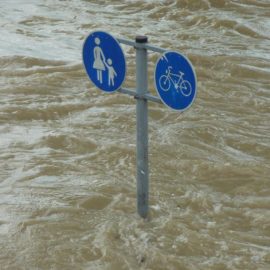
How high will flood insurance rates go? When will the exceed my mortgage payment. Stand by!
Denham Springs resident Kevin Macaluso was surprised to get a quote for a new flood insurance policy that showed an increase of more than 500%. Macaluso had been buying flood insurance for his home since 2015 and usually paid $569 each year for coverage. His house sits in a flood zone with minimal to moderate risk, so he’s not required to buy insurance by his mortgage lender. The flood policies — purchased separately from regular property casualty insurance — can cover up to $250,000 for homes, with an additional $100,000 for contents. But his policy lapsed for two days due to a delay in the mail and his new premium was $3,489 for one year of flood coverage, which included a higher deductible. One of the mitigating factors? A ditch more than 3,000 feet away from his home. “I was shocked,” Macaluso said. “I have no water around me. We did not flood in 2016 at all. For it to go up almost $3,000 in one year is robbery. I think they are trying to price out individuals. I would totally understand if I was in a major flood zone but I’m not in a that category.”
theadvocate.com
At that cost, do you buy it or not. I could not get a mortgage with out flood insurance so if cancel what happens? It may well force people to move.
For now, he’s undecided about whether to buy the federal insurance and is looking to get a quote through the private flood market to compare rates. Due to changes in the National Flood Insurance Program, homeowners seeking new flood insurance policies across Louisiana have been quoted significantly higher rates than in prior years. The rate hikes slated to go into effect Friday are for new policies only. In April, all new and existing flood insurance policies could be increased up to 18% or homeowners could see savings. The average NFIP premium in Louisiana is $878 each year. The rates being quoted for low-risk properties are higher than FEMA’s earlier estimates that roughly 70% of flood insurance policyholders in Louisiana would see increases up to $120 each year and fewer than 3% of policyholders would see increases of $240 per year or more. The agency said 20% of existing flood policies would see immediate savings in October.
Some do want the increase to be delayed but not to scrap the new rates.
While a coalition of politicians, including U.S. Sens. Bill Cassidy and John Kennedy sought to delay the rates, the program changes are still moving forward. FEMA officials suggested there may be more policyholders in the program because the rating process is more streamlined and personalized for each property instead of relying on decades-old flood maps. “We’re committed to closing the insurance gap. Clearly not enough property owners across the country have the necessary flood insurance protection they need,” said David Maurstad, senior executive of the NFIP.
There is a cap on what can be charged but it is a very high one and looks like it would only help mansions.
There is a cap that no single family home insurance premium will be higher than $12,125, though less than 1% of policies nationwide would be so costly, according to FEMA. “It’s still too early to determine exactly how pricing will be affected,” said Patty Templeton-Jones president of Florida-based Wright Flood, which underwrites policies for the national program, in a statement. In about five years about half of the policyholders will have premiums closest to the real cost of flood risk, which means that premiums for the most risky homeowners are likely to increase until that threshold. Estimates are the price hike will cause nearly 900,000 people, or almost 20% of policyholders, to drop flood insurance over the next 10 years, according to internal FEMA documents.
This is a new way to calculate the rates and it meant that more people were in flood zones.
FEMA says 2.8 million National Flood Insurance Program quotes have been generated under the new program nationwide. The rate changes are expected to impact 5 million policyholders nationwide, with 3.8 million paying higher premiums and 1.2 million seeing savings. “We developed a system that will adapt our rates and our risk analysis for climate change,” said Maurstad. The flood maps were not changed during the process. The old rules used FEMA data, flood insurance zones, base flood elevation, foundation type and the annual chance of flooding to determine premiums. The new rules include more sources of information, such as third-party business data, the cost to rebuild a property, distance to bodies of water, flooding type, ground elevation, height of the first floor and how often floods strike a particular community.
Calculating rates is not an easy process as there are many variables that have to be considered.
Roy Wright ran FEMA’s flood insurance program until 2018 and remembers the beginning of the recalculation process. Wright now runs the Insurance Institute for Business & Home Safety. “Insurance is a complicated thing, you’re trying to price risk,” Wright said. “If you own a home, don’t let your insurance lapse.” In a typical year all the National Flood Insurance Program policies increase between 5% and 9%. The affordability measures are up to Congress, he said. “I think what’s truly extraordinary that despite the climate change variability there are communities who will see savings, I think that should give people confidence. I don’t think it’s fair to tell 24,000 families in East Baton Rouge that their price can’t go down even though the math very clearly says it should,” Wright said. “We can’t hide the risks from people because the price is too high, we’ve seen the impact of these events.”
I guess I will find out in April what my rates will be and I do not expect them to drop!



